Sexual Knowledge
Anal Sex
This is a type of sexual intercourse where a man puts his erect penis into his partner’s anus and rectum. Anal sex is common among homosexual men. And many heterosexual couples experiment with anal sex but it is not practised as frequently as vaginal intercourse.
Stimulation of Anus during sexual activities can be done manually, orally or by anal intercourse.
For many persons, anal sex in any form can be highly arousing and can lead to orgasm. However, there are large number of people who have strong negative attitude towards it.
Unlike vagina, rectum does not produce its own lubrication. Therefore the tissues are more prone to damage and thus there are more pain and chance of infection is higher. Bleeding also takes more easily and readily hence, spread of infections like HIV and Hepatitis B is faster thru anal intercourse.
Also anus has a large number of bacteria particularly E. Coli hence, it is always advisable to use condom for anal intercourse. If the penis is inserted into anus first, then it should not be subsequently put in the vagina unless it has been thoroughly washed.
Anal intercourse can a source of discomfort for both the partners. The anal sphincter tightens when the insertion is attempted so, insertion can be distressing. If more force applied then anal injury is possible hence plenty of lubrication is necessary.
However, it must be kept in mind that “Anal Intercourse” is considered as an offence according to Indian Penal Code section 377 and both the partners can be penalised.
Andropause (Male Menopause)
It is a clinical condition characterised by partial deficiency of Testosterone in men after middle age. This is somewhat similar to menopause in women. The decline in hormone is associated with the altered state of well being, reduced work stamina, irritability and in some cases sexual dysfunctions like decreased sex drive and erectile dysfunction.
It is also known as PADAM (Partial Androgen Deficiency in Ageing Male) or LOH (Late Onset Hypogonadism).
In women, the menopause is a definite event which has an onset and finish. Menopause has specific symptoms. Whereas in Andropause, the onset is not well demarcated and may not have clear symptoms.
Common symptoms are..
- Changes in mood (depression), decreased intellectual capacity, anger and fatigue
- Reduced sleep (Insomnia)
- Reduced sexual desire and Erectile dysfunction
- Decrease in body hairs and skin changes
- Decrease in muscle mass
- Increase in visceral fat
- Decrease in bone calcium causing osteoporosis
Laboratory Testing :
Blood levels of Testosterone shows normal variation thru out the day. Highest values are seen at 8am and the lowest in the late afternoon.
Testosterone levels less than 300 ng/dl in young man should be considered hypogonadal.
Testosterone levels less than 150 ng/dl in old man should be considered hypogonadal.
Other tests that can be done are... blood test for anemia, other hormones (FSH, LH, Thyroid etc).
Treatment :
Treatment mainly consists of Testosterone replacement therapy. Therapy can significantly improve their sense of well being, increase in muscle and bone mass, virility and libido. Testosterone is available in injection forms (testosterone enanthate), oral gelcaps (testosterone undecanoate), transdermal gel (Mesterolone) and transdermal patches.
Before starting the Testosterone replacement therapy, one must do tests like Haemoglobin, serum lipids, liver enzymes and PSA (Prostate Specific Enzyme). These tests should be performed every 6 months after initiation of the therapy and annually there after. Digital examination of Prostate should also be done to check for the enlargement of the prostate.
Circumcision
It is a surgical removal of foreskin of the penis. It is carried out mainly for religious (Muslims and Jews), some times traditional purposes (some African tribes) and also for medical (phimosis, paraphimosis, candidial infection) purposes.
Circumcision in adults is done under local anaesthesia. The procedure takes about 30-40 minutes and hospital stay may be for 4 hours.
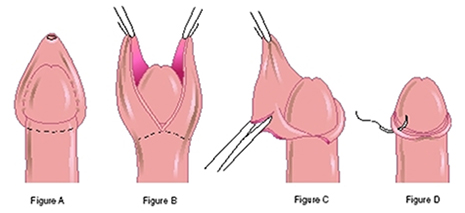
Circumcision as such offers no distinctive advantages. However, accumulation of smegma (sticky discharge from the under-surface of foreskin) can be avoided and it is easier to clean the glans penis.
Some believe that the chances of infections and cancer of penis are less in circumcised men although it is not very well proved.
Also some believe that the circumcised men will not have ‘premature ejaculation’ because the glans penis is de-sensitised.
Female Circumcision :
It is a surgical removal of the clitoral hood. It is supposed to increase the sensitivity of the glans clitoris. However, it is not a useful procedure at all.
In many countries of North East part of Africa and some countries of middle east, partial or total removal of clitoris (clitoridectomy) is done. This is known as Female Genital Mutilation (FGM).
The main aim of FGM is to inhibit a woman’s sexual feelings. Most often the mutilation is performed before puberty, often on girls between the age of four and eight, but recently it is increasingly performed on nurslings who are only a couple of days, weeks or months old.
Contraception (Family Planning methods)
Contraception means avoiding child bearing (pregnancy). It is also known as Family Planning as it involves planning to improve quality of life by deciding how many children one should have.
Most couples are expected to have children immediately after marriage and it is assumed they would be ready to cope with the demands of ‘responsible’ parenthood. Hence, each couple needs to decide whether to have children or not, if yes then how many and at what interval. They should also decide when they will be ready for the parenting. Parenting is very demanding. Also in current scenario, when both the partners may be working, it becomes more important to think about family planning.
CONTRACEPTIVE METHODS
Eunuchs (Transgenders)
The eunuchs of India, commonly known as ‘third sex’ or ‘Hijra’ or ‘Transgender’ have always been a community much talked about. They share good and bad reputation equally. Their presence is sought at many auspicious occasions like childbirth and marriages but ironically majority of the society is still afraid of them. Many times they are made the subject of ridicule and are laughed upon.
Historical aspect :
HIjdas are a part of human society from the ancient time.
• Mahabharat : The most famous references in Mahabharat are that of Shikhandi and other is Arjun’s 1 year stay as Bruhanalla who was a dance teacher.
Aravan Temple in Koovagam, Tamilnadu : In the battle of Mahabharata, Krishna (in the form of Mohini) marries Aravan (son of Arjun) as a sacrifice suggested by Goddess Kali to end the war. Aravan is sacrificed the morning after the marriage night. Mohini (Krishna) grieves the death of her husband.
The same is ritually enacted by Transgender (Hijras or Aravanis) where they tie their marriage knots (Thali) with Aravan and the next morning after his sacrifice enact Mohini by mourning and wearing white clothes.
• Ramayan : When Lord Ram was exiled from his native Ayodhya to the forest for fourteen years, he turned around to find out that most of the people of Ayodhya had followed him halfway. He said “Men and Women, turn back”.
And with that those who were neither men nor women did not know what to do, so they stayed on. They were still there when Lord Ram returned to Ayodhya fourteen years later, and he blessed them and said there would be a day when they would rule the world.
• Ayyappa temple in Shabarimala, Kerala : The myth of birth of Ayyappa says that Vishnu (in the form of Mohini) and Shiva coupled after the Amrit Manthan or the churning of oceans to issue a new godchild.
• Historical Context : Devi Renuka : Renuka-daughter of a Brahmin, married to sage Jamadagni and was the mother of five sons
One day while she was at the river, she saw a group of youths engaged themselves in water sports and forgot to return home in time which made Jamadagni to suspect her chastity.
He ordered his sons one by one to punish their mother but four of them refused on one pretext or the other. The sage cursed them to become eunuchs and got her beheaded by his fifth son, Parashuram.
Renuka's head multiplied by tens and hundreds and moved to different regions. This miracle made her four eunuch sons and others to become her followers, and worship her head.
• Historical Context : Bahuchara mataji : She and her sister were on journey with a caravan when a marauder named Bapiya attacked their caravan.
It was common practice in charan men and women if overpowered by their enemies, not to surrender but to kill themselves.
When Bapiya attacked the caravan, Bahuchara and her sisters announced tragu and cut their breasts.
Legends tells that Bapiya was cursed and became impotent.
The curse was lifted only when he worshiped Bahuchara Mata by dressing and acting like woman.
• Mughals and Nawabs : Eunuchs were selected to guard the women of the Harem. Majority of the time the Transgenders are not accepted culturally, nor socially and nor politically and not legally. By puberty when it becomes obvious, many families disown such children. Either they are subjected to various treatments including some violent tortures or they are marginalized in the society.
Majority of them are biologic men who believe that they have female spirits trapped in male body. They like to be recognized as females. They change their name to female one and also like to wear the feminine clothing. Many undergo hormonal treatment to develop breasts and LASER therapy to permanently remove facial hairs. Many of them who are dis-satisfied with their body and male sex organs go even for sex change operation known as Sex Re-assignment Surgery (SRS).
Transgenders themselves also show significant variations in their behavior, mannerisms and sexual preferences. Often they are mis-understood by the medical fraternity too and are often mis-diagnosed and are subjected to many unwarranted treatments.
Hence this community often remains in the dark shadow, away from the light of social acceptance. Since they are not in the main stream of the society, it is extremely difficult for them to find mainstream jobs. Hence, begging on the road and sex trade are the main source of income for this group.
Some of them are disowned by the family or some leave home voluntarily and join the cult known as “Gharanas”. They are adopted by their guru. The guru teaches them dancing skills. Those who are in preparation for castration (removal of testes) are known as “Akwa” hijdas. Those who continue to wear male attire are termed as “Khada Kothis”. Those who have removed their genitals and testes are known as “Nirwan Hijdas”.
The male temple prostitute is known as “jogta”. They are the male children dedicated to Goddess who cross dress themselves.
Those having feminine character are known as “Kothi”. They take female role in a relationship with other man. They are usually involved as receptive sex partners or perform oral sex. The male sex partner of kothi is known as “Panthi”. They show the penetrative sexual behavior. Whereas those who do both roles are known as “Double decker”.
Those who are involved in begging on the streets are known as ‘Mangati” and those involved in singing and dancing on occasions like weddings and child birth are known as “Badhai”
Some important sexual behavior of Hijdas
- They usually do not have a steady sexual partner. Multiple sexual partners put them in more risk.
- Most of them do indulge in anal sex passively, which again makes them more prone to STI infections.
- They usually stay in groups mostly in unhygienic and unhealthy surroundings.
- Since ‘anal sex’ is a penalized act, they are often sexually exploited by the law enforcers and police
- Gender dysphoria (confusion about sexual identity) amongst them makes them more susceptible for various sexual variant behavior including unsafe sexual practices
HIV – AIDS
HIV is Human immunodeficiency Virus. The defence mechanism in human body fights the infections and diseases. The HIV damages vital defence mechanisms and gradually destroys it. It takes several years for HIV to damage the immune system so much that a person becomes ill. During this period, the HIV infected person may look, feel healthy. In fact, in many cases, the person may not know that they are infected with the virus.
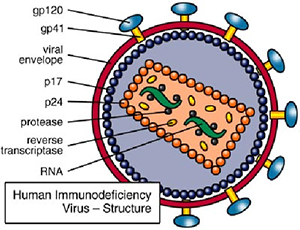
AIDS is not a single disease but it is basically a group of many diseases which affect people infected with HIV. With people having weak immune system, the common and otherwise harmless organisms can cause severe illnesses. In spite of severely damaged immune system, many people live for longer periods and are in a position to work. Many people infected with HIV finally develop AIDS. The period varies from person to person - 5 to 15 years and even more in some cases
How HIV spreads :
Since HIV is not a contagious like cold or flu, it is not spread merely by touching or shaking hands or staying together. Following are the main ways of transmission.
- 1. Unprotected penetrative sex ( vaginal or anal)
- 2. Transfusion of infected blood and blood products.
- 3. Use of infected needle or syringes (clinic or drug addicts)
- 4. Mother to child
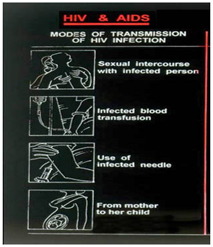
How HIV does not transmit :
HIV is not transmitted through everyday contacts or social contacts.
HIV is NOT transmitted thru...
- • Shaking hands, hugging, touching
- • Sneezing, coughing or sitting close
- • Share house, work place
- • Sharing swimming pool, toilet facilities, utensils, towels, books
- • Mosquito or any other insect bites
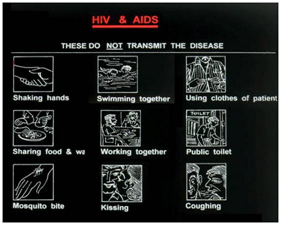
Signs / Symptoms of HIV-AIDS
Major Signs :
- 1. Weight loss of more than 10% of the body weight
- 2. A month long fever
- 3. Chronic diarrhoea for more than a month
- 4. Chronic cough since more than a month
Minor signs :
- 1. Generalised skin itching
- 2. Recurrent Herpes Zoster
- 3. Oro-pharyngeal candidiasis ( fungus infection in mouth)
- 4. Generalised swelling of lymph nodes
Presence of at least 2 major signs associated with at least 1 minor signs can be indicative of AIDS
Diagnosis of HIV :
This is done thru blood test only. Just by looking or having done the clinical examination, one can not detect the HIV.
HIV tests detects whether or not there are special substances called ‘Antibodies’ in the blood. Antibodies are produced by the immune system to kill the disease producing agent. When HIV enters human body, antibodies against to it are produced. These antibodies are detected by various tests.
ELISA test : most commonly used test. should be done after 12 weeks of contact
P24 antigen test : can be used when the early diagnosis is required (after 6 weeks of contact)
Polymerase Chain Reaction (PCR) test : most reliable test for early detection. Both quantitative and qualitative tests are available. Also helps in knowing the viral load too.
Western Blot test : this test is used as a confirmatory test when ELISA test is reactive .
Other methods like Tri-dot, Rapid test etc can be used in screening tests.
PCR, western blot tests etc are used to confirm the diagnosis when the screening test shows the positive result.
Meaning of the test results :
- A negative result means that the antibodies to HIV have not been found in the blood. It takes about 3 months (12 weeks) for the antibodies to develop and show up in the result. Another test after 3 months may be needed to confirm the result.
- A positive result means that antibodies to HIV have been found in the blood and also indicates that the infection of HIV has occurred. The infection is life long. A positive result does not predict when a person is going to develop AIDS but it gives an opportunity to closely monitor immune system.
Period of 12 weeks after the HIV exposure of infection is called “Window period”. Following 5 to 15 years period is without any symptoms hence called “Asymptomatic phase”. The phase after that is with various symptoms is called “Symptomatic phase”.
Progress of HIV infection :
1. Acute phase : this occurs in 2-6 weeks of exposure. Mild fever, general body pain, joint pains, throat pain etc are the non-specific symptoms which can easily be misdiagnosed as mild flu. In this phase, viruses rapidly replicate and spreads all over the body particularly lymph organs.
2. Asymptomatic phase : in this phase, the viruses settle in the body. They start gradual destruction of the human immune system. They destroy T helper White Blood Cells (WBCs) and later CD4 WBCs are targeted. Reduction in CD4 cells cause serious complications in the immune system of the body. This stage may last for 3-15 yrs and in some cases even longer.
3. Symptomatic phase (AIDS) : This stage develops when the opportunistic infections raise their heads and later multi-system failures start developing
There may be more than 10% weight loss. The lymph nodes get enlarged and they remain enlarged. The fever may develop which may not respond to the routine treatment. The cough and diarrhoea (loose motions) may develop. The person may not have appetite.
Chart
HIV infection :
After its entry in to the human body, HIV has an affinity towards the lymph glands and lymphocytes (a particular type of white blood cell).
HIV is present in all body fluids but it is present in infective dose only in blood, semen and vaginal secretion.
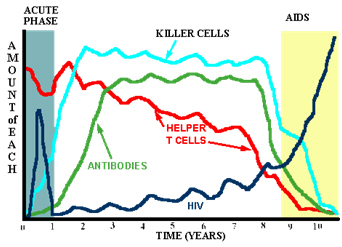
HIV/AIDS and STIs
Sexually Transmitted Infections (STIs) are those which are transmitted primarily thru sexual route. HIV is primarily a STI. Sexual route is the most important mode of transmission of HIV.
Presence of STI is a mark of high risk sexual behaviour which also predisposes a person to HIV too. Presence of STI, facilitates transmission of HIV by as much as 30%.
Almost all types of STIs are totally curable. Only HIV progresses to AIDS and it can not be cured. Early diagnosis and effective, prompt treatment of STIs will contribute significantly in reduction of HIV transmission.
HIV and Pregnancy :
In case of HIV infection it is advisable to consult a doctor, nurse or a trained counsellor, before pregnancy. The transmission of HIV to the new born can be prevented through appropriate treatment.
It is also possible to pass the HIV during pregnancy or childbirth. The chance of transmission is 15 -40 %. Breast feeding can also cause HIV infection. Use of Anti Retroviral therapy reduces the chance of transmission very much significantly.
Due to transmission of maternal antibodies HIV antibody tests can not be used to diagnose HIV infection in the new born.
antibodies can be detected for up to 18 months. In the new born baby, Non-antibody assays for early detection of HIV infection has to be used like p24 antigen, Viral culture and Detection of viral genes (either HIV DNA or HIV RNA).
TREATMENT of HIV infection :
There are 3 main components in the management..
1. Prevention of opportunistic infection : this can be observed by following healthy diet and regimen. Balanced diet at regular time and adequate sleep and rest are essential to keep immune system in healthy condition. Avoiding tobacco consumption and alcohol is also beneficial. Coping with all types of stress successfully keeps the person active and healthy.
2. Treatment of opportunistic infection : prompt treatment of the symptoms prevents rapid deterioration of the body symptoms. Diet supplements are beneficial. Tuberculosis (TB) is one of the most common and most dreaded infection in this stage.
3. Anti Retroviral Therapy (ART) : when the immune system gets too much compromised, then one must think of starting ART. When the CD4 count drops to less than 350/ cu mm or when the viral load increases to more than 30,000 copies / ml or when the symptoms of AIDS are present, ART should be thought of. Important points to ponder for ART are as follows.
1. Antiretroviral drugs are a treatment for HIV or AIDS. They are not a cure. They may slow down the onset of AIDS.
2. Although the treatment is not so expensive but the regular availability of the required medicine should be ensured.
3. Antiretroviral drugs have to be taken daily for the rest of the person’s life
4. Anti-retroviral can have severe side effects. One must go to a qualified medical person who is experienced with antiretroviral drugs.
5. Antiretroviral combinations also have to be changed often. Hence regular follow up to the doctor may be necessary.
Following are the ART drugs..
1. Reverse Transcriptase inhibitors (RTIs) : Zidovudine(AZT/ZDV), Stavudine (d4T), Didanosine(ddI), Lamivudine, Abacavir , Navirapine(NVP), Delavidine etc….
2. Protease Inhibitors (PI): Nelfinavir, Ritonavir, Saquinavir , Indinavir etc.
Usually Highly Active ART (HAART) is started which includes combination of at least 3 drugs. This is necessary to attack the virus and not to develop drug resistance.
Before starting the ART, general body check up and complete investigations are carried out. Later every 6 months, essential tests are done to monitor person’s vital parameters.
During treatment, One must be very careful about the various advertisements regarding “cure” of AIDS that may appear in various media. Before starting such therapies, one should obtain opinion of the knowledgeable physician.
Homosexuality
The word ‘homosexual’ comes from the Greek root. ‘homo’ meaning same. It’s a noun that describes men or women who have a preferential sexual attraction towards the people of their own sex over a significant period of time.
Homosexuality between two males is also known as “Gay” orientation whereas the same between two females is known as “Lesbian” orientation.
Some individuals, men and women, are sexually attracted to people of either sex are known as “Bisexuals.”
Although, homosexual behavior has existed throughout history all across the globe, most of the countries, including India, condemn the act of homosexuality. In 1974, The American Psychiatric Association officially decided that homosexuality was not an illness. Afterwards, more and more countries, uphold the civil rights of homosexuals. Many countries have stopped discriminating people on the basis of their sexual preferences.
In India, the act of homosexuality is considered as “an un-natural sexual act” and could attract penal prosecution under section 377 of IPC.
Theories of origin of homosexuality:
Despite extensive research, there is no firm agreement about what causes homosexuality. Many views are postulated.
1) Genetic theory: Many homosexuals claim that their sexual orientation is the result of biological forces over which they have no control or choice. They are born with genetic program to have same sex preferences.
2) Hormonal factors theory : this theory speculates that prenatal sex hormone excess or deficiency in humans may be associated with homosexuality.
3) Psychological theory : Disturbed parent-child relations might lead to homosexuality. It was found that many of the homosexual men had overprotective, dominant mothers and weak or passive fathers. Some suggested that homosexuality results from fears of heterosexual interactions.
4) Behavioral Psychology : Sexual fantasies can be conditioned. A positive sexual encounter with a homosexual partner can become the source of fantasy during masturbation, which is reinforced when it is followed by orgasm.
Homosexual Behaviour
In the initial stages of sexual interaction, most committed homosexual couples begin with a generalized approach of hugging, caressing or kissing, nipple stimulations etc. Mutual masturbation and Fellatio (oral sex for penile stimulation) seems to be the most common form of gay male sexual activity.
Anal Intercourse (sodomy) is another common male homosexual practice. The active agent is the one who performs the act and the passive agent is the one on whom the act is performed. When performed on a female partner, it is termed as Buggery. And when performed on a young boy, termed as Pederasty.
Mutual genital stimulations and Cunnilingus (oral sex for clitoral stimulation) are the common female homosexual behaviors.
Psychological Adjustments of Homosexuals
1. Most of the societies are still Anti-homosexual (Homophobic). It is considered a crime, sin, nuisance, illness. Hence, often they constantly struggle in marriage, family, friend circle, job and society.
2. Tendency not to disclose their identity.
3. Tendency for multiple partners. Stable relationship is rare.
4. Female homosexuals hardly come forward for treatment.
5. Some people, who remain away from the opposite sex for longer periods like jail inmates, armed forces personals, sailors etc. may be Situational Homosexuals meaning they get aroused by the person of same sex when opposite sex in not available.
Management of Homosexual person
It should be kept in the mind that homosexuality is not a disease.
Only those individuals who are not comfortable with their own sexuality and those who wants to be heterosexual can go for the therapy. These are Ego-dystonic people. The remaining are Ego-syntonic who enjoy their homosexuality comfortably and never want to change themselves. (see chart below)
Gradual Systemic De-sensitization is a kind of behavioral therapy which can be attempted in selected cases. Patients are taught to feel relaxed. In relaxed frame of mind they are taught to have heterosexual fantasy. Those bisexual individuals who have some interest in opposite sex can be benefited.
Various psycho dynamically and analytically oriented therapies are practiced by trained psychotherapists in which meaning of homosexuality, motives, pattern of relationship and early experiences of life are exposed.
Advisory: On July 2, 2009, the Delhi High Court overturned a 148-year-old British colonial law proscribing homosexual intercourse as "carnal intercourse against the order of nature."
The court stated, "Indian constitutional law does not permit the statutory criminal law to be held captive by the popular misconceptions of who the LGBTs (lesbians, gays, bisexuals and transgenders) are. It cannot be forgotten that discrimination is antithesis of equality and that it is the recognition of equality which will foster the dignity of every individual."
In Dec, 2013, the Indian Supreme Court, in a mockery of justice, reinstated the 1861 British colonial law criminalizing sex between consenting adults of the same gender. With this defenseless, cowardly and shameful decision, more than 130 million Indians were instantly turned into criminals and the Indian constitution blackened.
Marriage Conflicts
Marriage with the changing patterns of the modern world, are facing crisis which leads to marital discord. The expectations in marriage are romantic and high. However, with the greater understanding between the partners and that of marriage itself can become an exciting lifelong experience. This requires preparation and guidance before and after marriage. The social, cultural, economical, sexual, psychological aspects of marriage need to be looked at more realistically by the couples before stepping into a lifelong partnership. With the changing gender roles and values, both the boy and girl need greater understanding of their various multifaceted roles.
Marital Bliss is not a fairy tale ending. Actually, after marriage the real life begins where the basic qualities of an individual starts coming into life.
It is observed that More than 60% of the divorcing couples separate in first year of the marriage means discord starts early indicating POOR PREPARATION for the marriage and this is fully avoidable if proper care would have been taken in planning.
The changing social and cultural atmosphere, media influence, gender equality, higher education and economic independence in women have changed the structure of marriage. Lack of proper communication and often family members’ influence also affects the marriage very badly.
What is “poor preparation” in marriage
- • A person may have wrong criteria for partner selection : be specific how your partner should be. Don’t have unrealistic expectations.
- • Incomplete information : about the person, family background, religion and customs, educational and professional background etc.
- • Lack of flexibility and unwilling to adjust : be specific what you can adjust and what you can not. This prevents conflicts in future
- • Stereo type roles : the world is changing fast. Rather than expecting stereotype role from the partner, one should be expressive about it. Have an open and healthy communication.
- • More importance to trivial things : ask yourself if a particular thing is more important than the partner
- • Freedom of space for both the partners
- • Cheating by giving wrong information or hiding factual information about educational, financial status, health issues and previous major illnesses.
Conflicts in marriage are NOT always bad or detrimental.
Often, they provide relief from marital monotony. Conflicts may help the stereotype roles and typical thinking. The conflicts help to give a channel to express displeasure and anger towards the partner.
However, whenever the conflicts arise, the arguments should be limited to the disputed issue only. One should not drag the nonrelated issues. Stretching onto Irrelevant issues lead to complications and more hostility.
When the conflict is resolved successfully, it strengthens the marital bond.
Causes of Marital Conflicts :
There may be temperamental, personality and emotional clashes. Clashes may be about interests, values and attitude. There may be sexual disorders and Infertility related causes too.
Other issues like dowry, control over money, privacy, extra-marital affairs also are significant.
In laws’ no interference or over interference may also cause tensions in the marital relationship.
Growth in Marriage :
A marriage can become an enriching experience and can be a great strength for a person if the couple finds the novel ways to keep marital harmony. Following points are useful to the couple.
- • Healthy communication : open communication is the major key to successful marriage. One should share not only pleasures but pains too
- • There should be appreciation whenever and wherever it is needed. And constructive criticism too
- • Stay silent at appropriate moments
- • Have more sensitivity for each other
- • Remember men and women are different and they have different emotional needs
Men expect more appreciation, trust, acceptance and encouragement from the woman.
Whereas women expect caring, understanding, respect and appreciation from her man.
Masturbation
Self stimulation of the sex organs to produce sexual gratification is known as masturbation. It may or may not lead to orgasm and/or ejaculation.
It is one of the natural and commonly practiced methods. It does not lead to any mental and/or physical harm. Though there are many misconceptions regarding masturbation, the underline fact is that it is a normal activity and not a disease.
Time immortal the act of ‘masturbation’ has always been considered an act of ‘sin’ and is considered harmful to the morale and body. It was considered ‘self abuse’ or even ‘unnatural act’ since many centuries. Almost all religion and all cultures condemned it. There were several myths associated with the act of masturbation. People discussed and practiced various physical constraints and diet to avoid masturbation.
Gradually, in 20th century, Doctors started realising that Masturbation does not cause neither mental nor psychological problem. They relied more on research rather than speculation. Till today, no research has established that masturbation is harmful act. Still, however, there are number of myths that are very strongly rooted in the society and in the mind of the people. Various cults and so called religious leaders are also responsible for keeping the myths about masturbation.
There are large number of individuals who believe that masturbation is doing harm to them. Right from head from toe, almost all the diseases are connected to the habit of masturbation. Because of these myths, many people feel afraid, anxious and guilty about it. These feelings can lead to loss of sleep, excessive sweating, worry about sexual potency and loss of concentration.
Actually, it is not the act of masturbation but excessive thinking and feeling guilty about it causes lots of psychological problems in an individual.
Reasons for masturbation :
- • It is a form of sexual exploration and satisfaction enjoyed by males and females of all age groups.
- • Situational masturbation is common in boarding schools, hostels, prisons etc. (Where there is absence of partner of opposite sex). It is practiced due to circumstances.
- • Those unmarried persons who do not have readily available steady partner, mat resort to masturbation.
- • Many married person also indulge into the act of masturbation when... the partner is staying away, not well, unwilling. Some people find masturbation more pleasurable than sexual intercourse because they can enjoy the solo (self) sex more than the sex with partner because in solo sex there is no pressure to perform with partner.
Both, men and women masturbate. However, the proportion varies. Men, since young age learn it early than girls because men have external sex organs which can be easily manipulated.
Most boys find it accidently that touching the penis gives them pleasure whereas some boys learn it from the other elder boys. Many infants and very small children also derive
pleasurable sensation by manipulating or rubbing their penis. This activity is innocent and harmless without any sexual thoughts. The parents should not get annoyed and they should not punish the young boys.
Techniques of masturbation :
People use a wide variety of methods of sexual self pleasuring. Some practice with the same methods again and again with minor variations whereas some people experiment with a number of masturbatory techniques. Men usually follow same methods. Some hold the penis in fist and jerks, some hold by fingertips, some roll between the two palms, some rub it against the bed to derive the pleasure until they reach climax.
Women masturbates by rubbing the pubic area, vaginal lips or stimulate the clitoris directly or indirectly or pressing the thighs together rhythmically. Very small number of women may insert finger or any other elongated objects in the vagina to derive pleasure.
Fantasy plays very vital role in sexual arousal and masturbation. Many find it more pleasurable since they can have liberty to fantasy about anyone. Some may prefer to watch porn pictures or movies while masturbating. Many get aroused by erotic pictures/movies and then resort to masturbation to get sexual release.
Many people use some objects like vibrator to enhance the sexual pleasure.
There is no rule regarding the frequency of masturbation. It can be done as much as an individual finds it comfortable.
“Do”s of masturbation :
• It should be done whenever a person is aroused and feels the need to release the sexual urge
• It should be done in isolation / privacy
• It should be done at ease and not in a hurry
• It should usually be associated with sexual fantasy or erotic stimulation
• It should be done with positive frame of mind and not associated with guilt
“Don’t”s of masturbation :
• It should not be done in public or in group
• One should not make it a habit to relieve stress or getting sleep
Menopause
“Meno” means month and “Pausis” means to halt.
Menopause is ending of women’s menstruation. Ovaries produce a hormone – oestrogen which ripens egg in the ovaries with the help of another hormone – progesterone and gets uterus ready for each month for a fertilised egg. When there is no fertilisation, the lining of the uterus is lost thru vagina. This is known a s menstruation or menses or periods. This cycle happens every month from puberty.
Oestrogen is responsible for maintenance of skin lustre, bone, urinary system and the lining of the vagina. As menopause approaches, ovaries begin to produce less and less of the hormones. Periods become more and more irregular. Ovaries produce little or no oestrogen, no more eggs ripens and the women loose the capacity to be pregnant.
The average age of menopause is 42-48 yrs in Indian women. However, in some cases it may be as early as 36 and as late as 52 yrs too.
Climacteric : the climacteric is a phase in women’s sexual life, which starts before and continues after the menopause. The effect of this phase is spread over 3-4 yrs.
Changes in menstruation : as a woman approaches menopause, the periods may become irregular, may become heavier or lighter than usual, may become more or less frequent.
Hot flushes and Night sweats : these are the most common menopausal symptoms. A woman may suddenly feel hot and heat seems to rise on the face. This may last for few minutes and occurs several times in a day. This may be related to anxiety, stress or excitement. There may be palpitations (rapid heartbeats) too. Headache and loss of sleep is also commonly seen.
Changes in Sex organs : loss of pubic hairs, vaginal walls become thin and less lubricated leading to dryness and soreness in the vagina. Clitoris become smaller, labia also reduces in size. There may also be frequent urination too. There may be decrease or some times increase in sex desire.
Other body changes : hairs on head reduces, there may be wrinkling of the skin, bones become brittle and the breasts may sag.
Psychological changes : sleep disturbance may lead to fatigue and tiredness. Nervousness, depression, lack of concentration etc may be present. Irritability and mood swing are major symptoms. Adjustment with family members and friends seems difficult. Some women consider menopause as end of womanhood and resent too much on it.
The psychological changes and other changes vary greatly in different women. Some may experience very little while some feel them very strongly. This is also dependent on the physical health and emotional state of the individual woman. Some may not be ready to accept this ageing phenomenon.
Management of Menopause :
Proper diet, exercise, adequate sleep etc can keep good condition of woman. Multi vitamins also help. Calcium supplement helps to keep bones in healthy state.
Hormone Replacement Therapy (HRT): in this therapy, hormones which are depleting in the body system are supplemented by external supply. There are certain advantages and disadvantages too for this therapy.
HRT consists of low dose of oestrogen and progesterone which helps in replacing the body’s own loss after menopause. Woman on HRT will have regular periods just as if they have never approached the menopause.
Advantages : it provides relief from the unpleasant symptoms of menopause.
• Effective in preventing hot flushes and night sweats• Reduces osteoporosis (weakening of bones)
• Vaginal lubrication continues, making sex comfortable
• Helps reduce depression, emotional state
Dis-advantages :
• Risk of breast and endometrial cancer may increase• Prolonged or heavy bleeding may take place
Oral Sex
Contact of mouth of one partner with the genitals of the genitals of the other is known as “Oral Sex”.
Stimulation of the male genitals by tongue, lips and mouth is known as Fellatio and oral stimulation of the female genitals is called Cunnilingus.
Either form of oral-genital sex can be performed with one partner stimulating the other individually. Simultaneous reciprocal stimulation is known as 69.
Fellatio and Cunnilingus are used to induce or enhance sexual pleasure.
Vatsyayan has also mentioned about oral sex in Kamasutra as “auparishtak”
Licking, sucking, kissing and rubbing of genitals always feels good. The glans penis is very sensitive to oral stimulation. Many women are highly aroused by licking and sucking of clitoris during cunnilingus.
Some women do not want man to ejaculate in her mouth, though there is no health risk in swallowing semen.
Oral sex is quite common and many see it as normal and pleasurable part of love making.
However, there are many persons who consider it dirty, perverted and un-natural. Many think genital as unhygienic.
Scientific ally, there is nothing wrong with such activities and can be done if both the partners find it pleasurable and are agreeing for it and are keeping genitals organs in good hygienic condition.
Oral sex with unknown and unreliable partner is not safe.
If one of the partners is not ready for it, then the other partner should try to convince gently without force.
Pre-Marriage Counselling
One of the most important facets of life is marriage. Usually, it is a life time partnership.
Young people look at the marriage as an exciting experience. But, marriage with the changing patterns of the modern world, are facing crisis which leads to marital discord. The expectations in marriage are romantic and high. However, with the greater understanding between the partners and that of marriage itself can become an exciting lifelong experience. This requires preparation and guidance before and after marriage. The social, cultural, economical, sexual, psychological aspects of marriage need to be looked at more realistically by the couples before stepping into a lifelong partnership. With the changing gender roles and values, both the boy and girl need greater understanding of their various multifaceted roles.
Right from financial management to mehandi arts course, so many courses are available but unfortunately, there are no courses or curriculum that is available to make a marriage successful. The young girl and boy are expected to be an ideal groom and bride like a film. How can this happen naturally..??
Both have grown into different families with different methods of upbringing, in different families with variable value systems. To come together and live happily for the entire life, both need to be equipped well before entering into a marital relationship. It does not happen naturally as it is generally believed.
People do not plan to Fail but they fail to Plan.
There is so much attention given to the wedding as an event. Lakhs of rupees are spend on the clothes, venue, decoration, food, drinks, celebrations, fireworks etc. but little importance is given towards the compatibility in the relationship. People plan their wedding very meticulously for months but spend hardly they spend any time to prepare for the life after marriage. They are more concerned to match their wedding suits but do not realise the importance of matching their nature, adjustments and values system. They chose their honeymoon destination very carefully and may spend extravagantly but hardly prepare themselves for the sexual relation, contraception and parenthood. This may ultimately lead to stress, friction, lack of communication and interpersonal grudge and hostility between them when the things do not go according to their wishes.
People pay much more importance to the wedding and not Marriage.
During the courtship period (time period between engagement and marriage), they should spend more time in meaningful realistic conversation rather than talking crepe. Rather than boasting about ourselves, the couple should present a near real picture about themselves. Being romantic is not wrong but in doing so, one must not overlook the obvious signs of disagreement.
Important points to look upon by an aspirant bride / groom.
- • Meaning of marriage in present social context.
- • Courtship : golden period to know each other and planning for life after marriage
- • Role of sex in marriage : preparedness for sexual relation
- • Contraception (family planning)
- • Parenthood
- • Home management
- • Financial management. More important if both the partners are working and earning
- • Laws related to marriage
Psycho-Sexual Counselling
It is a process about creating new perspectives and change. The change may be inside the person or it may be in helping them to change an aspect of their behavior.
The goal is to achieve better personal adjustment and growth by stimulating the person to exploit his/her potential and use more of his/her resources
The theory of counseling is based on the belief that ‘Human beings have an innate potential for positive personality change.’ Hence, the role of the counselor is to provide the client with a situation where growth and change can occur.
For psycho-sexual counseling, ‘behavioral approach’ is seen to be more useful. This approach arises from ‘learning theory’ and is based on the following beliefs
- • Human behavior is learned
- • Maladaptive behavior can be unlearned
- • More positive behavior can be substituted.
Here one focuses on a specific sexual problem and manage that rather than attempting to promote or bring about a major personality change. Sex counselor also has to be sexuality educator since many sexual problems arise out of ignorance about the sexual responses.
Counselling is NOT giving advice or offering solutions to the problem.
In sexual dysfunctions, counselling helps the person to change attitude, perception of self or others, habits and behaviours.
Goals:
- • To help reduce the level of anxiety when put in the stressful situation
- • To help bring about a meaningful change
- • To facilitate client’s decision making process
SEXUALLY TRANSMITTED INFECTIONS (STIs) or VENEREAL DISEASES
These are the infections occurring in the humans and are spread through the sexual contacts from one person to the other. These infections primarily affect the organs of sexual contact like penis, vagina, anus, mouth and sometimes other organs as well.
They are caused by bacteria, viruses, parasites, protozoa etc..
Many people think only prostitutes, homosexuals or promiscuous people get STIs, but anybody who is sexually active can catch one. If an individual had unprotected sex with a person with STI, then he / she is at high risk of catching that STI. The migrant workers, prison inmates and those persons who are fond of having multiple partners are at more risk.
STIs can cause serious complications, especially in women and new-born babies. Failure to diagnose and treat STIs at an early stage may result in serious sequels like infertility, fetal wastage, ectopic pregnancies and cancer. STIs adversely affect the community through social, psychological and economic impact. STIs facilitate transmission of HIV infection.
The most common sexual activities that can spread an STI from one partner to another include:
- Vaginal sex : the man's penis in the woman's vagina
- Anal sex : the man's penis in the partner's anus (the partner can be either male or female)
- Oral sex : the man's penis in the partner's mouth, or the partner's mouth or tongue in the woman's vagina
- Oral-anal sex : one partner's mouth or tongue on the other partner's anus.
Ulcer, swelling and inflammation on the sex organs are the common symptoms of STIs. Some STIs can cause urethral/vaginal discharge and pus formation, swelling in the groins and pain in the pelvis (lower part of abdomen).
There are nearly 26 STIs including HIV-AIDS. Some common ones are described below.
1. Syphilis : This is infection is caused by a bacteria known as ‘Treponema pallidum’. This is a chronic infection which can run for years if not treated completely.
1. Primary stage : an ulcer appears on the organ of contact after 3-12 weeks of contact. It is a single, painless, does not bleed and is hard. Within 3-4 weeks it disappears giving an impression that it is healed.
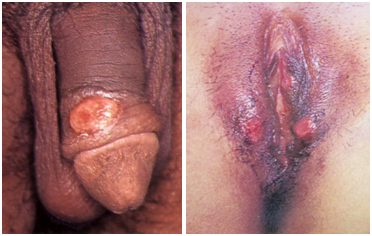
2. Secondary : after getting internalised, the disease spreads to other organs too. The symptom may take 2-6 months to appear. Heavy rash appears all over the body, jaundice may appear, flu like symptoms may come and there is general joint pains.
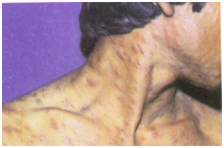
3. Tertiary : after few years, disease spreads to the more internal and vital organs like brain & spinal cord, heart, testes etc.
4. Congenital syphilis : If a woman suffering from Syphilis conceives, the baby has a very heavy risk of having congenital syphilis marked by some congenital deformities (by birth deformities)
2. Gonorrhoea : This infection is caused by bacteria “Neisseria Gonorrhoeae”.
Symptoms usually comes after 2-8 days of sexual exposure.
Symptoms are characterised by severe burning, itching in the urethra in both male and females. There may be thick yellowish offensive discharge from the vagina or urethra.
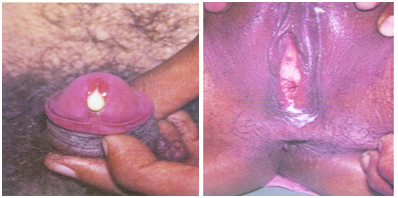
It can cause urethral stricture (narrowing of urethra), pelvic inflammatory diseases in females. Blockage in vas and Epididymis in men and fallopian tubes in women can cause infertility. If a pregnant woman has gonorrhoea, during delivery she can give it to the newborn baby which causes ‘ophthalmia neonatorum’ which can lead to blindness.
3. Chancroid : caused by bacteria “Haemophilius ducreyi”.
Here the infection is characterised by small, multiple ulcers around the genital areas which secret highly offensive pus. It spreads to other areas which come in close contact.
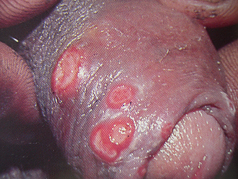
4. Herpes Genitalis : caused by a virus ‘Herpes Simplex Virus – HSV’. This infection is known for repetitive recurrences.
Some people may not have any symptoms. Some show symptoms after 7-15 days of sexual exposure.
There are small painful blisters on the organs which may last upto 2-3 weeks associated with itching and burning sensation.
When the blisters burst and then heal the person still has herpes. The viruses lodge in the nerve endings. These blisters have the tendency to come back again triggered by any physical and psychological stress.
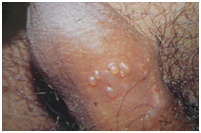
Herpes can cause stillbirth ( birth of dead child). During child birth it can be transmitted to the new born child possibly causing its brain damage.
5. Lympho granuloma venerium (LGV) : caused by bacteria “Chlamydia trachomatis”.
It cause enlargement of the lymph glands in the groins. The swelling my become an abscess with multiple openings and may result into permanent genital deformity
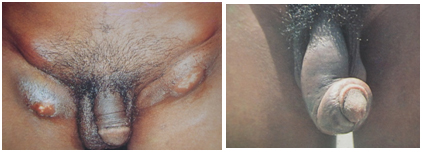
6. Candidiasis (Monoliasis): caused by a fungus “Candida albicans”
In men, it causes.. itching, irritation at the tip of penis. White discharge below the foreskin, swelling of foreskin and slight rash
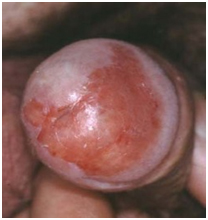
In women, it causes...itching, soreness in vagina. White curdy offensive discharge from the vagina
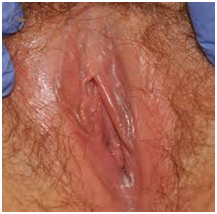
It must be remembered that Candidiasis occurs in some cases without sexual contacts also. In diabetes, pregnancy, poor hygiene it can occur spontaneously too.
Apart from these major infections there are other infections like Chlamydia, Non-gonococcal Urethritis, Granuloma Inguinale, Trichomoniasis, Genital Warts, pubic scabies, etc etc.
Important points to be noted
- All the STIs have different incubation periods.
- Often the history of sexual contact may be misleading.
- There may be usually mixed infections (more than one infection).
- Complete treatment requires complete antibiotic medication. It should not be discontinued even if there is partial relief.
- Often sexual partner should also receive treatment
- After treatment of STIs, HIV test is always advisable.
Steps for prevention and management of STIs :
- High risk behaviour (multiple partners, avoiding condom use etc.) should be discouraged. Avoid sex with casual or unknown partners.
- Young people should avoid sex until marriage and they should not succumb to friends’ pressure.
- Avoid alcohol consumption because it is observed that after alcohol intake, risk behaviour increases manifold.
- Take complete treatment to achieve cure and not just relief.
- Partner should also be given treatment simultaneously.
- During pregnancy, checking for STIs should be there to prevent transmission from mother to child.
Humour in sex





